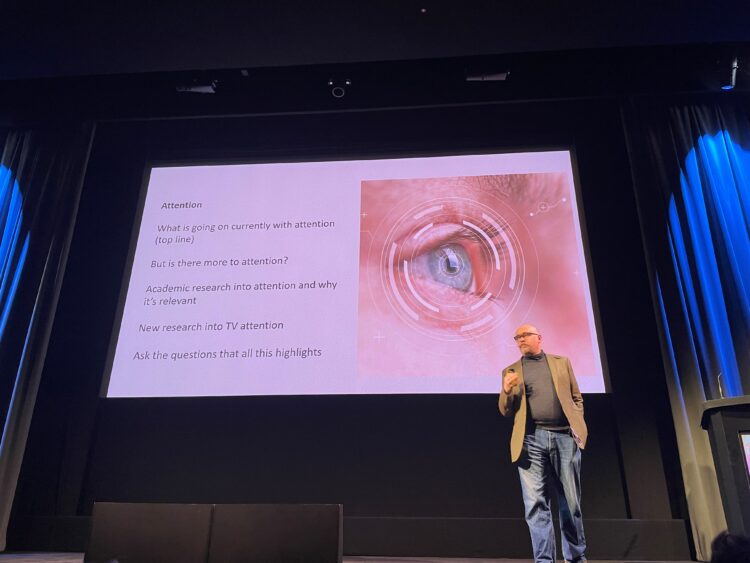Visual attention: our most valuable tool in measuring effectiveness

Opinion
We must not neglect the progress made so far in visual attention, while also acknowledging the value of audio, relevance, and experience in the complex journey to understanding attention.
Last week, BAFTA in London hosted a delegation of representatives from across the advertising and media landscape to hear perspective from UK TV marketing body Thinkbox about the new focus on Attention.
One of the key messages was that there is a lot of complexity to ‘Attention’ beyond visual attention (eye-tracking), which of course is true.
Dr. Ali Goode (pictured- main image) reminded us about how the human brain processes information and forms memory structures and how, while visual attention is a key stimuli, it’s just one of many that mean people are really paying ‘Attention.’
Much of the work on attention to date has been focussed on tracking visual attention.
Last week’s event reminded us about the value of audio, relevance, and experience as a part of the journey to assess full attention.
Attention measurement remains a challenge
The challenge is measurement. Visual attention is the only outward-facing signal of Attention that can be measured with real scalability.
While it does not capture the nuance of sound and other sorts of attention, it is a major advancement in how we consider different media experiences.
As someone who’s been involved in attention’s development as an approach to media since 2017, I have the context to take a step back and remember where this metric came from.
First and foremost, it is about “impression reform”. It does not aim to solve every question we have about advertising effectiveness; it seeks to bridge the vast gap between measuring how ads are served and their cost and evaluating which ads people truly look at and pay attention to.
To some extent, it also aims to give us better levers of optimisation in the buy process as we start to assess the value and quality of different media inventory sources beyond cost and scale, something sorely missing from media planning to date.
As Sam Gaunt from GSK put it, “Attention has the potential to be a huge step forward vs. where we are now in the digital space, where there is a lot of crap inventory. It represents a great opportunity to start quantifying and investing in quality inventory.”
Visual attention still meaningful
While visual attention is not perfect, from my perspective it is a good approximation of other elements of the media experience, so long as it is correlated to meaningful outcomes.
In previous research studies I have been involved with, we found that in measuring outcomes like brand recall, STAS and brand choice alongside visual attention, the effects of audio, viewing conditions and choice can be accounted for with reasonable accuracy.
Sam Gaunt from GSK also spoke about establishing the value of attention through econometrics, noting that visual attention has proven more valuable as a measurable optimisation lever than slow moving econometric models.
For example, although skippable ad formats on a well-known social video platform deliver less visual attention than the non-skippable formats, each second of attention to the skippable formats delivered a greater uplift in brand consideration than their non-skippable counterparts. This captures the effect of choice, articulated through the results.
The same can be said for audio. On TV for example, we saw a similar thing: more seconds of visual attention but also more ‘powerful’ seconds of attention, which delivered proportionately higher uplifts in brand metrics than other video platforms. This can be explained by the nature of the viewing experience, sound, screen size, shared viewing etc.
Understanding attention is a complicated journey
In the journey to fully understand ‘Attention’, which is a very nuanced and complex subject, we should not rush to disregard the progress made to date.
Tracking and monitoring visual attention to ads is a fundamentally huge step forward for media and advertising planners, allowing us to quantify the vast array of differing media experiences and better allocate budgets than current methods and metrics allow.
I have said it a few times and I’ll say it again, we don’t need to wait for a ‘common consensus’ on attention measurement and planning.
For those who take the time to digest the wealth of case studies and research out there, the approaches being offered in market now around visual attention or attention signals (device) are generating great results for brands.
Katie Hartley from Dentsu said it as well: “There is a lot of nuance to attention, but I hope that complexity does not hold up what is a positive move forward.”
Evolution is slow, but the strongest approaches will prevail, and in the search to understand total advertising effectiveness, attention can be a massive leap forward.
Jon Waite is global head of media experience activation at Havas Media Group.




